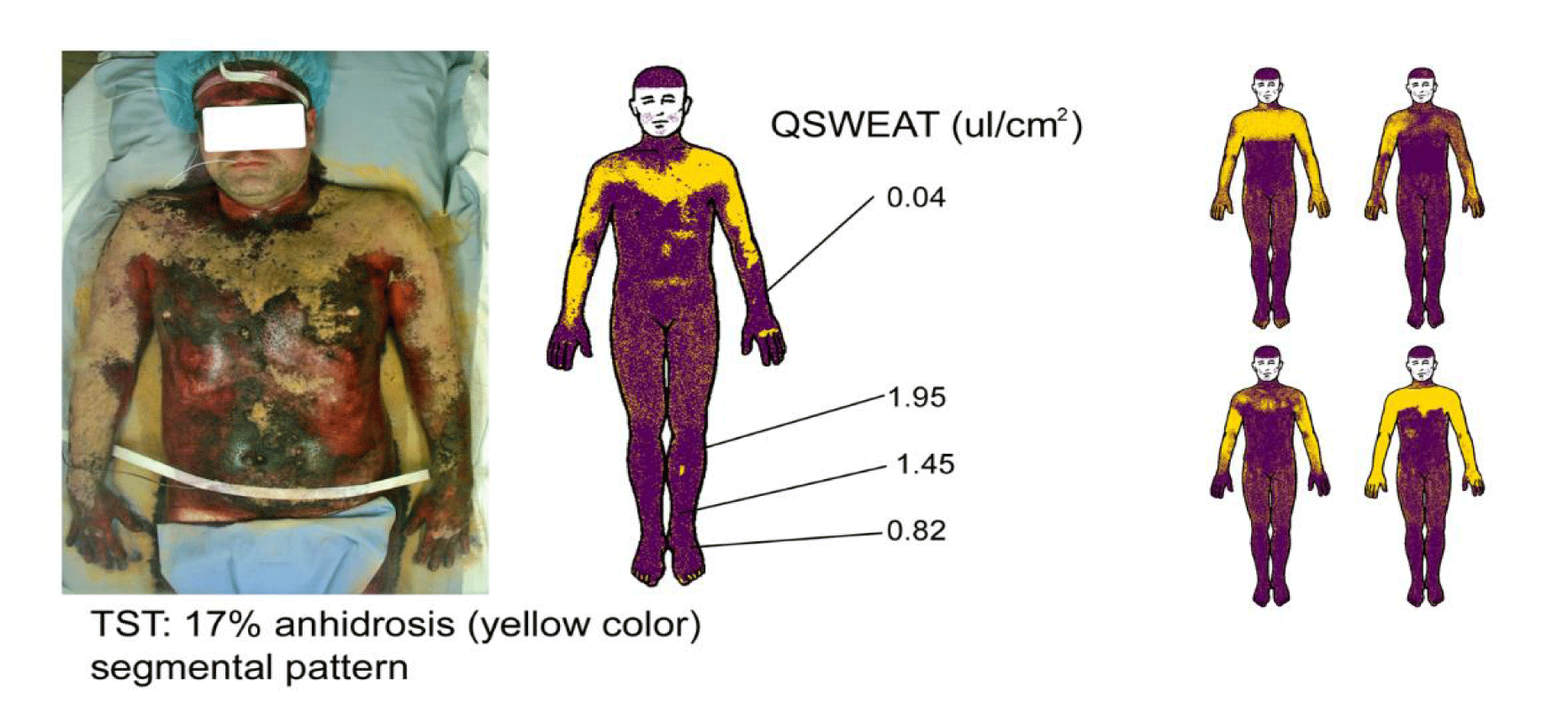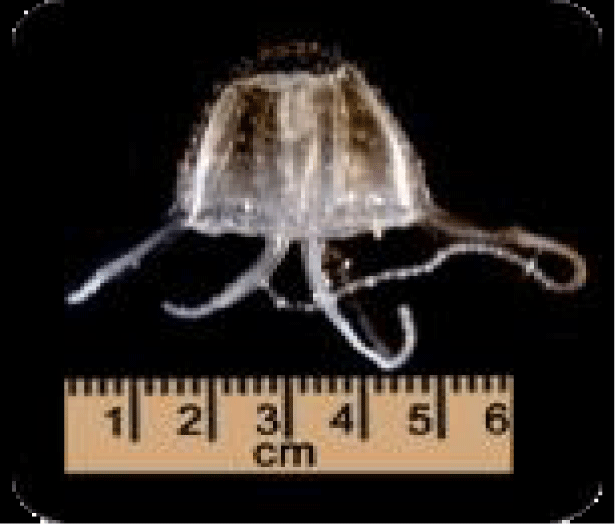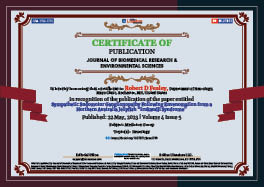Medicine Group . 2023 May 22;4(5):889-890. doi: 10.37871/jbres1749.
Sympathetic Sudomotor Ganglionopathy Following Envenomation from a Northern Australia Jellyfish “Irukandji Syndrome”
Robert D Fealey MD*
Introduction
The oceans of northern Australia coastal beaches harbor numerous venomous jellyfish. Several species cause Irukandji Syndrome, a severe disorder (developing within an hour after a sting) consisting painful muscle cramps, vomiting, sweating, agitation, vasoconstriction, prostration, hypertension, cardiac irregularities. The jellyfish toxin may modulate neuronal sodium channels leading to a massive release of endogenous catecholamines. Segmental sympathetic cardiovascular hyperactivity has been emphasized but this case report portrays a dramatic effect on segmental sympathetic sudomotor function.
A 34 yr. male reported stinging pain in the ear and neck while snorkeling off the coast of N Australia. Symptoms of severe muscle cramping pain, hypertension, tachycardia, dyspnea, diarrhea, sweating, agitation and prostration rapidly developed. He was treated in a local hospital with normal saline infusion and analgesics. "Irukandji Syndrome" due to Carukia barnesi jellyfish sting was suspected. Patient remained disabled, as standing, heat exposure, noise or touch of skin triggered a hyperadrenergic response with tachycardia, dyspnea, sweating of head and legs, hypertension, severe nocturnal erections and even aphonia. Improvement with fludrocortisone and clonidine was noted. Over next 4 years patient developed 'relapses' when attempting to increase his upright physical activity.
Neurological Exam
The patient’s neurological exam including deep tendon reflexes, muscle bulk tone and strength, and truncal and extremity sensory exam (to light touch and pin prick and cold stimulus) was entirely normal.
Medical evaluation at Mayo Clinic, Rochester MN
MRI of spine/head, CT of chest-abdomen-pelvis and urinary metanephrines were unremarkable. MIBG I131 scan (to help exclude pheochromocytoma, paraganglioma and to assess cardiac sympathetic innervation) was normal.
Autonomic evaluation at Mayo Clinic, Rochester MN
Autonomic testing was undertaken to help explain continued symptoms. Remarkable findings included: Lability of heart rate and blood pressure with a hyperadrenergic HUT (head up tilt) and elevated standing serum norepinephrine, (300 pg/ml supine 1070 pg/ml standing); attenuated cardiovagal response to deep breathing, near absent forearm QSWEAT response and dramatically impaired upper trunk and arm thermoregulatory sweating response mimicking a T2 or T3 sympathectomy. Ganglionic (neuronal) acetylcholine receptor and other antibodies were negative.
Figures 1 and 2 show the remarkable findings of the evaluation.
Discussion
Irukandji Syndrome is caused by the sting of several venomous jellyfish inhabiting the coastal waters of northern Australia. Documented cases have been caused by tiny jelly fish including Carukia barnesi (Figure 3), Malo kingi and others [1].
The mechanism of initial symptoms may include activation of TRPV1 channels [2] catecholamine and CGRP release and possible disruption of membrane sodium channels [3]. Cardiac smooth muscle is often targeted with elevated troponins and arrhythmia in some.
To my knowledge segmental sympathetic sudomotor failure mimicking sympathetic surgery [4] has not been described. Neurologic and autonomic abnormalities reported in the literature include an initial ‘catecholamine storm’ with systemic hypertension, sweating, pallor, nausea and vomiting, blurred vision due to mydriasis or decreased accommodation, palpitations [5]. Rarely prolonged autonomic abnormalities occur including impaired gastrointestinal and genitourinary motility and abnormalities in the RR interval during deep breathing (the last a measure of cardiovagal function) [6]. Different jellyfish have been reported to cause a mononeuritis multiplex [7].
Initial treatment involves securing the ABC’s, using vinegar to deactivate nematocysts, parenteral magnesium (to decrease catecholamine release), vasodilator meds to titrate BP and opioids to control severe pain. Clonidine has recently been shown to reduce the amount of opioids required for pain [8].
Conclusion
- Initial clinical presentation is compatible with Jellyfish sting and envenomation causing Irukandji Syndrome.
- Significant systemic and possible segmentally localized hyperadrenergic signs and symptoms evolved. The persistence of symptoms after 4 years and daily hyperadrenergic episodes (Figure 1) is atypical of Irukandji Syndrome however and required additional explanation.
- The dramatic and unexpected finding (Figure 2) of a segmental, upper thoracic, sympathetic sudomotor deficit, (simulating a T2 or T3 sympathectomy), suggests injury to sympathetic ganglion neurons. Possible mechanisms for injury include excessive systemic catecholamines effect, a direct effect of envenomation on neuronal membranes or an immune mediated response to envenomation targeting receptors or channels on autonomic ganglia [9] and producing a limited autoimmune autonomic ganglionopathy [10].
- Cardiovascular adrenergic innervation appears mostly intact but might be persistently overactivated because of the nearby segmental upper thoracic ganglionopathy and the occurrence of a "perilesional" or compensatory hyperadrenergic response in cardiac sympathetic innervation [11].
- The overall impact of patient’s Irukandji syndrome produced deconditioning (due to avoidance of upright posture, exercise, exposure to heat) and secondary anxiety contributing to his orthostatic intolerance syndrome.
- Current treatment with Clonidine and Magnesium appears to be effectively suppressing patient’s hyperadrenergic events and graded exercise, salt and fluids have assisted his reconditioning effort.
References
- Tibballs J. Australian venomous jellyfish, envenomation syndromes, toxins and therapy. Toxicon. 2006 Dec 1;48(7):830-59. doi: 10.1016/j.toxicon.2006.07.020. Epub 2006 Jul 15. PMID: 16928389.
- Xu X, Wang P, Zou X, Li D, Fang L, Gong K, Lin Q. The effects of sympathetic outflow on upregulation of vanilloid receptors TRPV(1) in primary afferent neurons evoked by intradermal capsaicin. Exp Neurol. 2010 Mar;222(1):93-107. doi: 10.1016/j.expneurol.2009.12.011. Epub 2009 Dec 28. PMID: 20036240; PMCID: PMC2824038.
- Winkel KD, Tibballs J, Molenaar P, Lambert G, Coles P, Ross-Smith M, Wiltshire C, Fenner PJ, Gershwin LA, Hawdon GM, Wright CE, Angus JA. Cardiovascular actions of the venom from the Irukandji (Carukia barnesi) jellyfish: effects in human, rat and guinea-pig tissues in vitro and in pigs in vitro. Clin Exp Pharmacol Physiol. 2005 Sep;32(9):777-88. doi: 10.1111/j.1440-1681.2005.04258.x. PMID: 16173936.
- Atkinson JL, Fealey RD. Sympathotomy instead of sympathectomy for palmar hyperhidrosis: minimizing postoperative compensatory hyperhidrosis. Mayo Clin Proc. 2003 Feb;78(2):167-72. doi: 10.4065/78.2.167. PMID: 12583528.
- Tibballs J, Li R, Tibballs HA, Gershwin LA, Winkel KD. Australian carybdeid jellyfish causing "Irukandji syndrome". Toxicon. 2012 May;59(6):617-25. doi: 10.1016/j.toxicon.2012.01.006. Epub 2012 Feb 14. PMID: 22361384.
- Burnett JW, Weinrich D, Williamson JA, Fenner PJ, Lutz LL, Bloom DA. Autonomic neurotoxicity of jellyfish and marine animal venoms. Clin Auton Res. 1998 Apr;8(2):125-30. doi: 10.1007/BF02267823. PMID: 9613803.
- Burnett JW, Williamson JA, Fenner PJ. Mononeuritis multiplex after coelenterate sting. Med J Aust. 1994 Sep 5;161(5):320-2. doi: 10.5694/j.1326-5377.1994.tb127455.x. PMID: 7830670.
- Isman A, Seymour J, Little M. Use of clonidine in the treatment of Irukandji syndrome: A 4-year retrospective cohort study on safety, efficacy and clinical utility. Emerg Med Australas. 2022 Aug;34(4):504-508. doi: 10.1111/1742-6723.14017. Epub 2022 May 31. PMID: 35638940.
- Ryan RYM, Seymour J, Loukas A, Lopez JA, Ikonomopoulou MP, Miles JJ. Immunological Responses to Envenomation. Front Immunol. 2021 May 10;12:661082. doi: 10.3389/fimmu.2021.661082. PMID: 34040609; PMCID: PMC8141633.
- Kimpinski K, Iodice V, Sandroni P, Fealey RD, Vernino S, Low PA. Sudomotor dysfunction in autoimmune autonomic ganglionopathy. Neurology. 2009 Nov 3;73(18):1501-6. doi: 10.1212/WNL.0b013e3181bf995f. PMID: 19884578; PMCID: PMC2779006.
- Thieben MJ, Sandroni P, Sletten DM, Benrud-Larson LM, Fealey RD, Vernino S, Lennon VA, Shen WK, Low PA. Postural orthostatic tachycardia syndrome: the Mayo clinic experience. Mayo Clin Proc. 2007 Mar;82(3):308-13. doi: 10.4065/82.3.308. PMID: 17352367.
Content Alerts
SignUp to our
Content alerts.
 This work is licensed under a Creative Commons Attribution 4.0 International License.
This work is licensed under a Creative Commons Attribution 4.0 International License.











